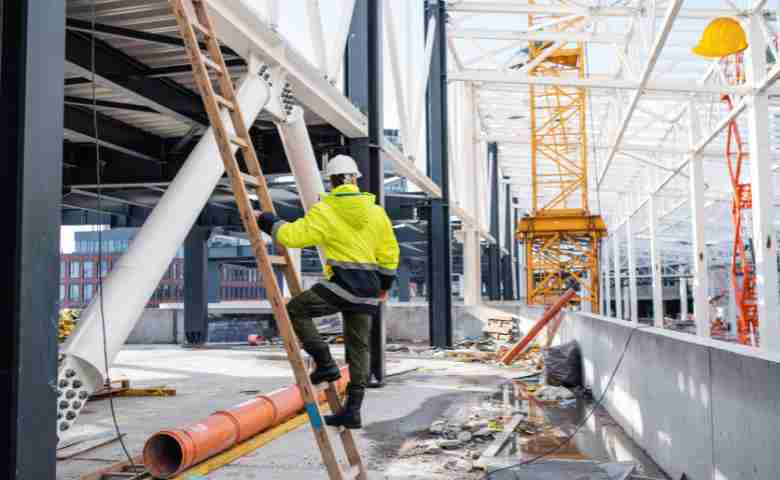Last Updated on November 1, 2024 by Admin
Construction sites are complex and potentially hazardous environments. Proper safety practices are crucial to prevent accidents, injuries, and costly project delays. A well-rounded construction site safety checklist is a proactive way to ensure everyone on-site is aware of potential hazards and is taking the right precautions. Here’s the ultimate guide to creating a comprehensive construction site safety checklist to keep workers safe and projects running smoothly.
1. Personal Protective Equipment (PPE)
- Helmets and Hard Hats: Inspect and provide fitted helmets to protect against head injuries.
- Eye Protection: Ensure everyone on site has access to safety glasses or goggles, especially when operating machinery or working with chemicals.
- Ear Protection: For sites with loud machinery, provide earplugs or earmuffs.
- Gloves: Use appropriate gloves for specific tasks, whether for handling hazardous materials or sharp objects.
- Reflective Vests: In high-traffic areas, reflective vests are essential for visibility.
- Fall Protection Equipment: For workers at height, inspect harnesses, lanyards, and anchors to prevent falls.
2. Site Security and Perimeter Control
- Fencing and Barriers: Set up secure fencing around the construction site to prevent unauthorized entry and reduce risks to the public.
- Signage: Post clear signs at the site entrance, hazardous zones, and near heavy machinery.
- Lighting: Ensure adequate lighting, especially during night shifts or in low-light conditions, to prevent trips and falls.
3. Tool and Equipment Maintenance
- Inspect Daily: Before each shift, inspect all tools and machinery for proper operation and repair any malfunctions.
- Proper Storage: Ensure all tools and equipment are stored in designated areas when not in use to reduce tripping hazards.
- Training: Ensure that operators of heavy machinery have up-to-date training and certification.
4. Hazard Communication and Labeling
- Material Safety Data Sheets (MSDS): Have up-to-date MSDS for all chemicals and hazardous materials used on-site.
- Clear Labeling: Label all substances, including gases and liquids, to prevent accidental misuse.
- Emergency Protocols: Communicate emergency protocols for hazardous material spills and other incidents.
5. Fall Prevention and Protection
- Guardrails: Install guardrails at all heights over six feet or in areas where falls could occur.
- Ladders and Scaffolds: Inspect ladders and scaffolds daily and ensure they meet OSHA standards.
- Training: Provide fall protection training, including ladder safety, scaffold use, and proper harnessing techniques.
6. Fire Safety and Electrical Precautions
- Fire Extinguishers: Place fire extinguishers at strategic points and make sure they are easily accessible.
- Electrical Safety Checks: Inspect electrical wiring and outlets regularly and use ground-fault circuit interrupters (GFCIs) where necessary.
- Emergency Exits: Ensure all team members know the location of emergency exits and evacuation procedures.
7. First Aid and Emergency Readiness
- First Aid Kits: Keep well-stocked first aid kits in accessible locations around the site.
- Trained Personnel: Ensure at least one person on-site is trained in basic first aid and CPR.
- Emergency Contact Information: Display emergency numbers prominently, including contacts for medical services, fire departments, and site managers.
8. Safety Training and Documentation
- Regular Safety Meetings: Conduct daily or weekly safety briefings to go over hazards and reinforce safety protocols.
- Site-Specific Safety Training: Provide specific training for each job role on the site, especially for new hires.
- Document Safety Protocols: Keep a documented safety manual that workers can refer to in case of questions. This is crucial information to share with a construction injury lawyer.
9. Housekeeping and Cleanliness
- Daily Cleanup: Ensure that all trash, debris, and excess materials are cleared at the end of each day.
- Designated Walkways: Keep walkways and staircases clear to prevent tripping.
- Proper Waste Disposal: Dispose of hazardous waste according to OSHA and local regulations.
10. Weather-Related Precautions
- Heat Protection: For hot days, set up shaded rest areas and provide water to prevent dehydration and heatstroke.
- Rainy or Snowy Conditions: In wet conditions, ensure non-slip mats are available, and consider postponing work in extreme weather.
- Cold Weather Gear: During winter months, supply workers with insulated clothing and gloves to prevent frostbite.
11. Safety Monitoring and Continuous Improvement
- Regular Site Audits: Conduct regular safety audits to identify potential hazards and compliance with safety protocols.
- Feedback Mechanism: Encourage workers to report any safety concerns or suggestions for improvement.
- Update Protocols: Periodically update safety protocols and checklists based on new OSHA regulations or changes in worksite conditions.
Final Thoughts on Construction Site Safety
A robust construction site safety checklist is essential for maintaining a safe and efficient work environment. By regularly reviewing and updating these practices, construction companies can protect their teams, prevent costly accidents, and comply with safety regulations. Ensure your site-specific checklist is up-to-date, and remember that safety is a shared responsibility – a well-prepared team is a safe team.
Creating a culture of safety is the key to minimizing risks on a construction site. For more detailed guides and industry-specific safety tips, make sure to consult OSHA guidelines or reach out to construction safety experts.
Related Posts:
ConstructionCareerHub App is LIVE — built ONLY for construction careers. Don’t apply with a weak resume.
Get ATS-ready Resume Lab + Interview Copilot + Campus Placement Prep (resume screening, skill gaps, interview readiness) — in minutes & Other advanced features.
Explore Smarter Construction Career Tools →Quick check. Big impact. Start now.
- Safety Precautions for Common Construction Risks
- The Essential Guide to Construction Checklists: Streamlining Your Projects
- Construction Quality Control Checklist: A Comprehensive List
- The Most Important Entry-Level Construction Interview Questions
- The Homeowner’s Essential Checklist for Annual Home Maintenance


